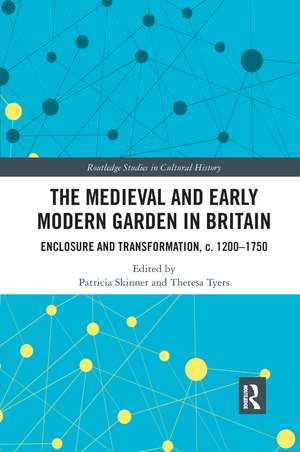The Medieval and Early Modern Garden in Britain: Enclosure and Transformation, c. 1200-1750: Routledge Studies in Cultural History
Editat de Patricia Skinner, Theresa Tyersen Limba Engleză Paperback – 31 mar 2021
| Toate formatele și edițiile | Preț | Express |
|---|---|---|
| Paperback (1) | 324.39 lei 6-8 săpt. | |
| Taylor & Francis – 31 mar 2021 | 324.39 lei 6-8 săpt. | |
| Hardback (1) | 820.56 lei 6-8 săpt. | |
| Taylor & Francis – 13 mar 2018 | 820.56 lei 6-8 săpt. |
Din seria Routledge Studies in Cultural History
-
 Preț: 311.41 lei
Preț: 311.41 lei -
 Preț: 310.08 lei
Preț: 310.08 lei -
 Preț: 664.74 lei
Preț: 664.74 lei -
 Preț: 311.41 lei
Preț: 311.41 lei -
 Preț: 311.41 lei
Preț: 311.41 lei -
 Preț: 310.88 lei
Preț: 310.88 lei -
 Preț: 326.78 lei
Preț: 326.78 lei -
 Preț: 313.60 lei
Preț: 313.60 lei -
 Preț: 315.70 lei
Preț: 315.70 lei - 9%
 Preț: 936.34 lei
Preț: 936.34 lei -
 Preț: 326.49 lei
Preț: 326.49 lei - 9%
 Preț: 934.80 lei
Preț: 934.80 lei -
 Preț: 280.29 lei
Preț: 280.29 lei - 6%
 Preț: 279.05 lei
Preț: 279.05 lei -
 Preț: 329.31 lei
Preț: 329.31 lei -
 Preț: 341.81 lei
Preț: 341.81 lei - 26%
 Preț: 849.37 lei
Preț: 849.37 lei - 5%
 Preț: 1290.15 lei
Preț: 1290.15 lei - 25%
 Preț: 852.88 lei
Preț: 852.88 lei - 25%
 Preț: 858.29 lei
Preț: 858.29 lei - 26%
 Preț: 822.34 lei
Preț: 822.34 lei -
 Preț: 438.56 lei
Preț: 438.56 lei - 26%
 Preț: 820.32 lei
Preț: 820.32 lei - 18%
 Preț: 1109.99 lei
Preț: 1109.99 lei - 18%
 Preț: 1055.51 lei
Preț: 1055.51 lei - 26%
 Preț: 821.53 lei
Preț: 821.53 lei - 18%
 Preț: 1058.79 lei
Preț: 1058.79 lei - 18%
 Preț: 1068.18 lei
Preț: 1068.18 lei - 18%
 Preț: 1058.65 lei
Preț: 1058.65 lei - 18%
 Preț: 1064.36 lei
Preț: 1064.36 lei - 18%
 Preț: 1110.74 lei
Preț: 1110.74 lei -
 Preț: 487.02 lei
Preț: 487.02 lei -
 Preț: 412.37 lei
Preț: 412.37 lei - 18%
 Preț: 1115.51 lei
Preț: 1115.51 lei -
 Preț: 489.10 lei
Preț: 489.10 lei - 18%
 Preț: 1057.09 lei
Preț: 1057.09 lei -
 Preț: 281.63 lei
Preț: 281.63 lei -
 Preț: 431.57 lei
Preț: 431.57 lei - 18%
 Preț: 1110.61 lei
Preț: 1110.61 lei - 18%
 Preț: 1054.71 lei
Preț: 1054.71 lei -
 Preț: 397.32 lei
Preț: 397.32 lei -
 Preț: 440.69 lei
Preț: 440.69 lei - 18%
 Preț: 1060.19 lei
Preț: 1060.19 lei -
 Preț: 442.12 lei
Preț: 442.12 lei - 18%
 Preț: 1052.38 lei
Preț: 1052.38 lei
Preț: 324.39 lei
Nou
Puncte Express: 487
Preț estimativ în valută:
62.08€ • 64.44$ • 51.76£
62.08€ • 64.44$ • 51.76£
Carte tipărită la comandă
Livrare economică 22 martie-05 aprilie
Preluare comenzi: 021 569.72.76
Specificații
ISBN-13: 9780367515447
ISBN-10: 036751544X
Pagini: 180
Ilustrații: 7 Tables, black and white; 3 Line drawings, black and white; 2 Halftones, black and white; 5 Illustrations, black and white
Dimensiuni: 152 x 229 x 13 mm
Greutate: 0.25 kg
Ediția:1
Editura: Taylor & Francis
Colecția Routledge
Seria Routledge Studies in Cultural History
Locul publicării:Oxford, United Kingdom
ISBN-10: 036751544X
Pagini: 180
Ilustrații: 7 Tables, black and white; 3 Line drawings, black and white; 2 Halftones, black and white; 5 Illustrations, black and white
Dimensiuni: 152 x 229 x 13 mm
Greutate: 0.25 kg
Ediția:1
Editura: Taylor & Francis
Colecția Routledge
Seria Routledge Studies in Cultural History
Locul publicării:Oxford, United Kingdom
Public țintă
Postgraduate and UndergraduateCuprins
Part I: Theorizing the Garden 1. Introduction: The Garden at the Intersection of Pleasure, Contemplation and Cure Patricia Skinner and Theresa Tyers 2. Gendered Spaces of Flourishing and the Medieval Hortus Conclusus Liz Herbert McAvoy Part II: The Historical Garden 3. Rills and Romance: Gardens at the Castles of Llywelyn ab Iorwerth and Edward I in Wales Spencer Gavin Smith 4. A Delite for the Senses: Three Healing Plants in Medieval Gardens, the Lily, the Rose and the Woodland Strawberry Theresa Tyers 5. In Dock, Out Nettle: Negotiating Health Risks in the Early Modern Garden Emily Cock Part III: The Imagined Garden 6. "To play bi an orchardside": Orchards as Enclosures of Queer Space in Lanval and Sir Orfeo Amy Morgan 7. Dressing the Pleasure Garden: Creation, Recreation and Varieties of Pleasure in the Two Texts of the Norwich Grocers' Play Daisy Black 8. Political Gardens in Early Modern English Drama Eoin Price Part IV: Gardens and Transformation 9. Horti Recidivi: The Restoration and Re-creation of Medieval Gardens in the 20th and 21st Centuries Manuel Schwembacher 10. Report on a Pilot Study of the Garden as a Place of Health and Well-being Sara Jones
Notă biografică
Patricia Skinner holds a Personal Chair in History at Swansea University.
Theresa Tyers is Research Fellow at Swansea University.
Theresa Tyers is Research Fellow at Swansea University.
Descriere
This book explores theories of the garden, historical sites and literary representations, from the thirteenth to the eighteenth century. It reflects on the impossibility of reconstructing premodern gardens "as they really were," and suggests that this is less important than learning how people in the past engaged with their environment.
